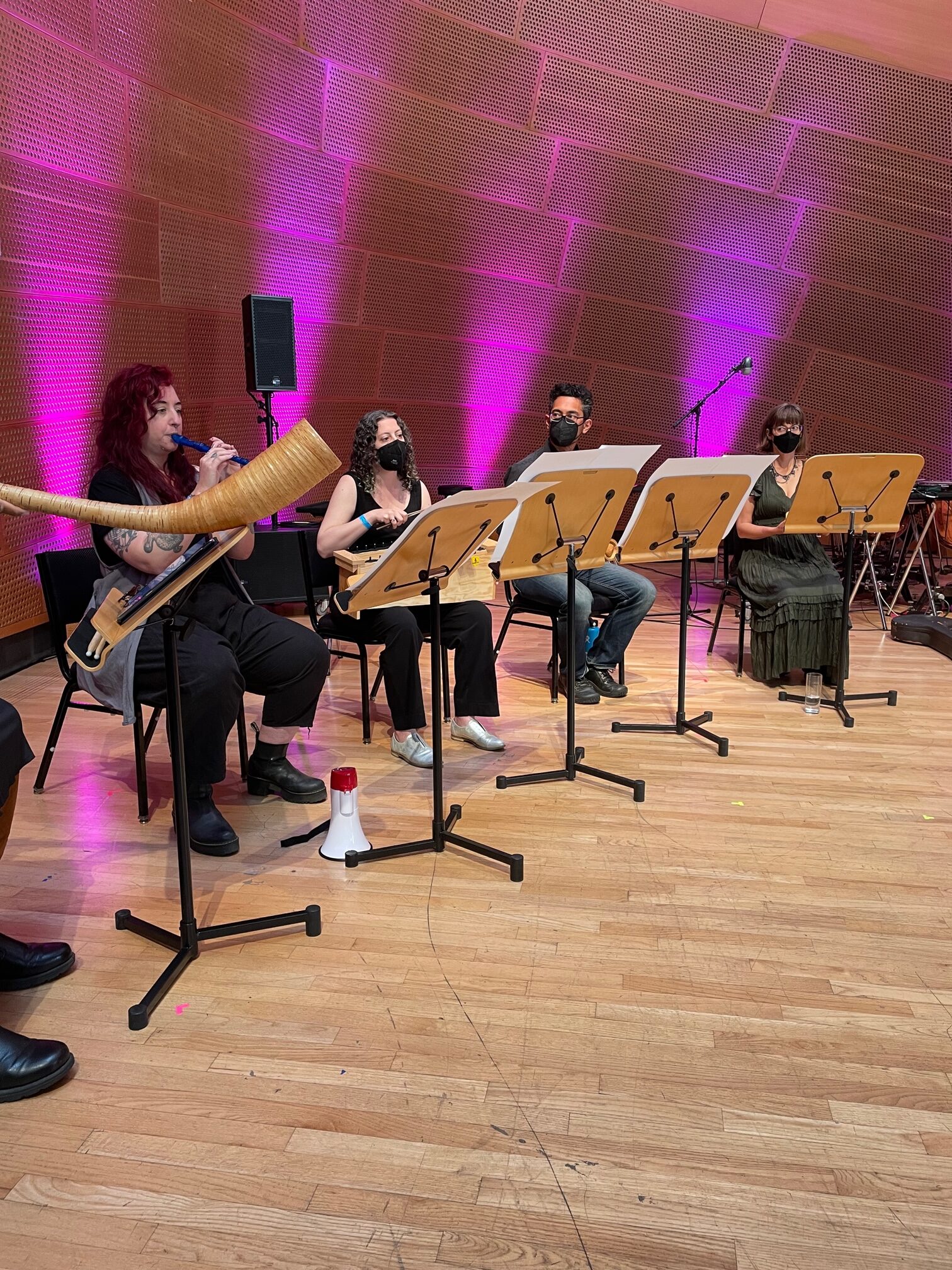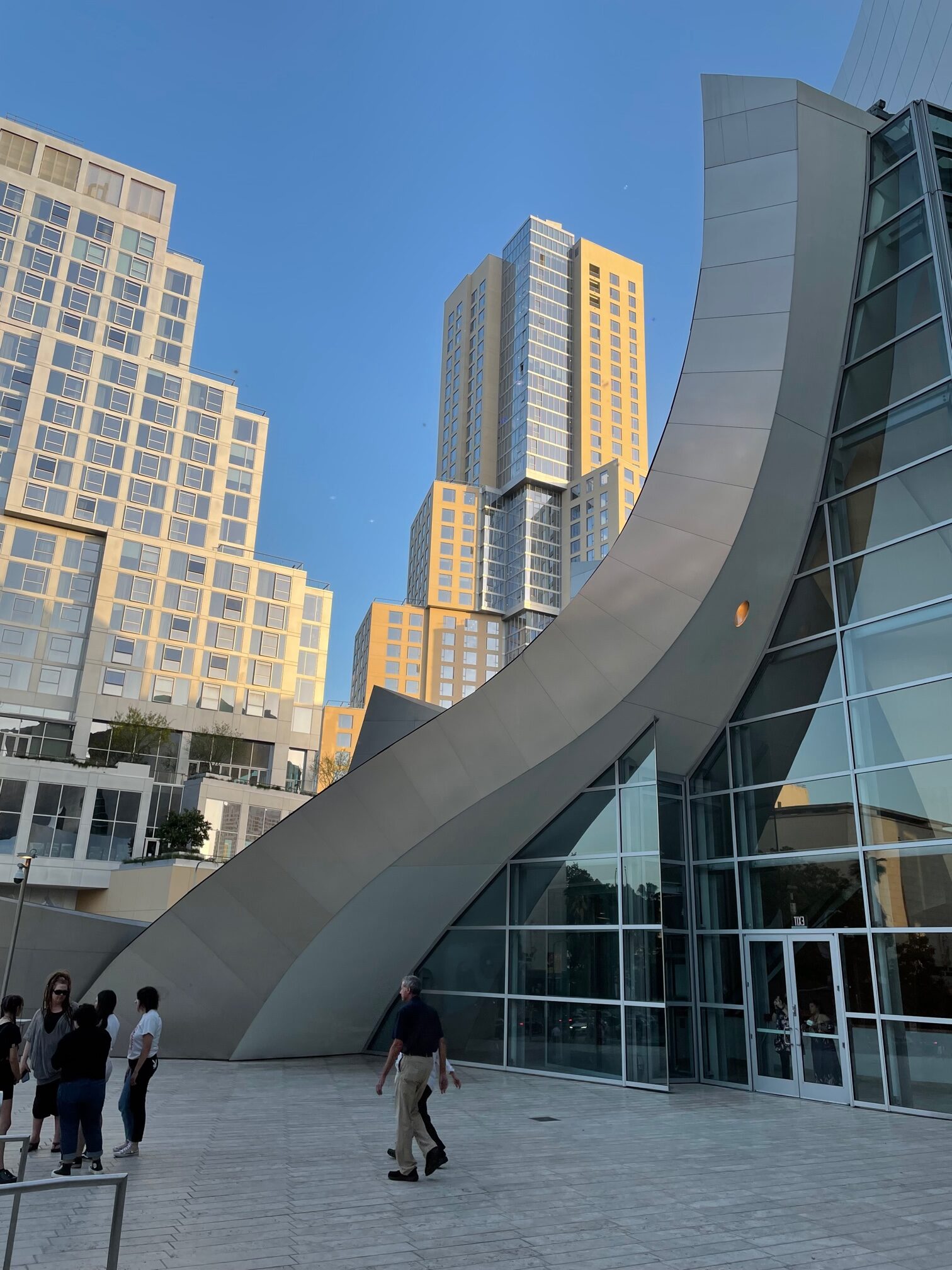Noon to Midnight – Part 1

On Saturday, April 9, after a pandemic-enforced hiatus of two years, the Noon to Midnight: A Day of New Music event returned to the Disney Concert Hall sponsored by the Los Angeles Philharmonic. This popular open house features local new music groups and performances throughout the Disney Hall venue. It is informal, low cost, and a chance to catch up with musical friends and listen to a variety of new sounds. The LA Phil commissioned a number of pieces and their New Music Group also performed. The many offerings overlap so you can’t hear all of it, but with 12 hours of new music scheduled, there is something for everyone.
Beginning exactly at noon, Tuning Meditation, by Pauline Oliveros, was conducted by Clare Chase in the cavernous BP Hall space. As the audience filed in, small printed cards were handed out that contained the entire score of Tuning Meditation. Ms. Chase explained that this was an audience participation piece and read out the instructions from the score: “Using any vowel sound, sing a tone that you hear in your imagination. After contributing your tone, listen for someone else’s tone and tune to its pitch as exactly as possible. Continue by alternating between singing a tone of your own and tuning to the tone of another voice. Introduce new tones at will and tune to as many different voices as are present. Sing warmly.”
Ms. Chase started this off with a clear pitch and began walking through the assembled audience who were all standing and scattered through the space. There were several hundred people present and since many were skilled musicians, a variety of lovely tones soon emerged. The various pitches swelled and subsided as new and exquisite harmonies spontaneously appeared and just as quickly evaporated. Layers of vocals enveloped the participants and the transcendental connections among this cloud of human voices was very moving. The normally challenging acoustic of BP Hall was, happily, not an impediment to the intimate exchange of musical emotion rising from so many voices. The Oliveros concept of Deep Listening is nowhere better illustrated than with Tuning Meditation – so simple, yet so very effective.
The Southland Ensemble next and the players formed a large semicircle to perform A Simple Opera, by Ben Patterson. This consisted of a narrator who began by speaking simple declarative phrases into a microphone, followed by an increasing series of short honks and plinks from the surrounding instruments. As the piece continued, the spoken phrases grew shorter while the instrumental bursts grew longer. This simple technique had the unexpected effect of cheerfully engaging the audience. The words from the narrator amounted to a brief explanation of the piece and a warm welcome to the Noon to Midnight event.
The Southland Ensemble made some quick configuration adjustments and soon began “Paragraph 2” from The Great Learning, by Cornelius Cardew, the English experimental composer. The ensemble was divided into three groups, each with a drummer, a lead vocalist and supporting singers. The text for the piece is derived from an English translation of the sayings of Confucius and each vocalist sings out a phrase as the other groups respond. All of this is independent and indeterminate, with much freedom of interpretation. There is no common tempo or pulse. The drummers individually select a rhythm from a list notated in the score, then change this as and when desired. The lead vocalist of one of the groups begins by singing out a phrase through a megaphone and this is supported by the other singers in that group. This call is then answered by the other two groups, often simultaneously and in a pleasing harmony.
The combination of independent drumming and the calling out by the vocalists creates a wonderfully primal feel, as if we are witnessing an important tribal assembly or ceremony. The singing and drumming are continuous, yet never become repetitive or tiring. The complete Great Learning is very long and only “Paragraph 2” was performed here. The strong drumming and use of megaphones for the vocals proved equal to the BP Hall acoustic distractions, and the performance carried to clearly the back of the space. This seemingly elementary and disorganized work, convincingly performed by the Southland Ensemble, carries a remarkable emotional punch; another example of the supremacy of the simple over the formal.
A little after 1:00 PM, pianist Vicki Ray performed a set of five pieces outdoors on the terrace, in the Keck Amphitheater. First was Improvisation and Fugue by Alfred Schnittke and this opened with dramatic and dissonant chords followed by trills and rapid runs of notes. Strong dynamic contrasts highlighted a dark and mysterious feel and the amplification system was effective getting the sound of the grand piano out into the audience. A few bars into the “Fugue” section, and just as a nice groove was developing, there was a sudden mechanical malfunction inside the piano. Ever the consummate professional, Ms. Ray calmly had the problem fixed and re-started the second section whose increasing complexity presently grew into a formidable technical challenge. There was no loss of precision or focus, however, and the piece ended quietly.
Majestic, composed by Wadada Leo Smith followed, and this began with a deep bass riff along with short, rapid passages in the middle registers that produced a grand feeling with just a hint of mystery. As this proceeded, an interesting back-and-forth between the lower register notes and strongly contending upper passages added a complimentary layer of artful intricacy. A few minutes into Majestic, the afternoon sun found a gap in the overhead tarps and was now shining directly into the eyes of Ms. Ray as she was reading the score from her iPad. Happily, this did not result in any noticeable reduction in the sharpness of her performance, which concluded uneventfully. Imprompu (À deux mains), by Mauricio Kagel was next and this featured quick spurts of notes followed by a slower and more deliberate sections. A similar theme was then repeated in the middle and lower registers and the piece oscillated between fast and playful and a slower, more dramatic phrasing.
A Cecil Taylor piano solo from Life as… followed, as transcribed and notated by Kaja Draksler. Who but Vicki Ray would even attempt to play such a thing? The piece was filled with a mind-boggling variety of grace notes, ornaments, styles and fragmentary quotes, all played at a furious pace. You could hear that Taylor’s improvisation was working off of phrases and riffs from the original accompaniment so that it constantly dipped and turned in unexpected directions. Absent its original context, the piece had a slightly choppy feel, but this was nevertheless a memorable performance. Who knew that eye and hand could be sufficiently agile to recreate such a masterful improvisation?
The set concluded with Ligeti’s Capriccio No. 2 and this was full of ups and downs, a pleasant lightness and lots of energy. With its active and playful feel along with a bright and engaging sensibility, this piece practically shouted ‘Capriccio’. With all that Ms. Ray had been through to this point, her playing did not disappoint.
Part II of this review will cover performances by Jacaranda Music, Joseph Pereira, Piano Spheres and Chris Kallmyer.
Please read Mark Swed’s fine review of Noon to Midnight in the LA Times for his excellent coverage of many of the pieces I was not able to hear.
